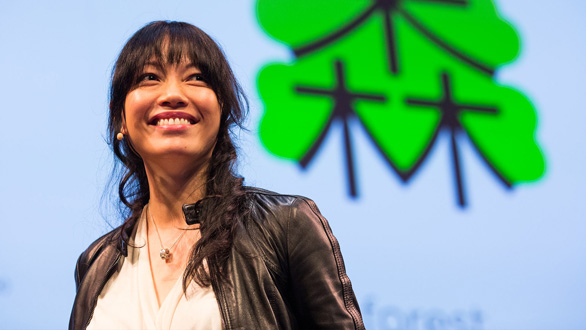 To an outsider, the Chinese language “seems to be as impenetrable as the Great Wall of China,” says ShaoLan Hsueh in today’s talk, given at TED2013. Hsueh’s mission over the past few years has been to break down that barrier, making reading and writing in Chinese accessible to people who didn’t grow up doing it.
To an outsider, the Chinese language “seems to be as impenetrable as the Great Wall of China,” says ShaoLan Hsueh in today’s talk, given at TED2013. Hsueh’s mission over the past few years has been to break down that barrier, making reading and writing in Chinese accessible to people who didn’t grow up doing it.
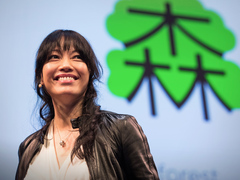 ShaoLan: Learn to read Chinese ... with ease!
Her solution? A method she calls “Chineasy.” To achieve basic literacy, Hsueh says, you need only know 1,000 characters, and the top 200 allow you to comprehend 40 percent of basic literature. Chineasy involves pairing characters with facial expressions, body movements and images that conjure up words in English.
ShaoLan: Learn to read Chinese ... with ease!
Her solution? A method she calls “Chineasy.” To achieve basic literacy, Hsueh says, you need only know 1,000 characters, and the top 200 allow you to comprehend 40 percent of basic literature. Chineasy involves pairing characters with facial expressions, body movements and images that conjure up words in English.
In her talk, Hsueh moves through eight foundational characters, describing mnemonic devices and showing artful depictions. “Open your mouth as wide as possible until it’s square,” she says. Are you doing it? Voila, the character for mouth: 口. Hsueh shows a graphic her team has designed of a person going for a walk, based on the character for person: 人. Fire is the character for person with what look like two arms waving, as if the person is engulfed in flames and yelling, “Help!”: 火. Hsueh also takes us through tree (木), mountain (山), sun (日), moon (月), and door (門), which “looks like a pair of saloon doors in the Wild West.”
These eight characters “are the building blocks for you to create lots more characters,” Hsueh explains. Using Chineasy’s simple, beautiful illustrations, it’s just a hop, skip and a jump to many other words and phrases. In this talk, Hsueh takes us through almost 30 characters; here, some more examples based on those foundational eight.
- In her talk, Hsueh shows the Chinese character for person, 人, which looks like a person strolling along. Multiply by two, and you’ve got the character for everyone:
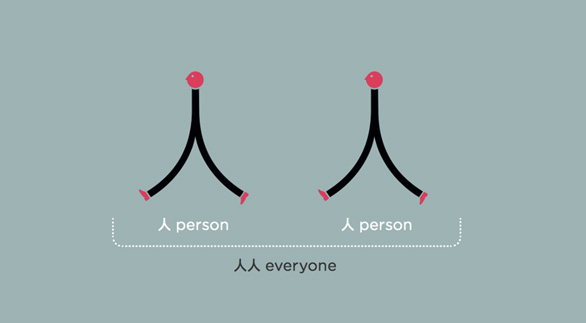 .
. - In her talk, Hsueh shows us how combining fire (火) and mountain (山) gives us a volcano (火山). What happens when we add a mouth (口) to a volcano? Think about it: the mouth of a volcano is … a crater!
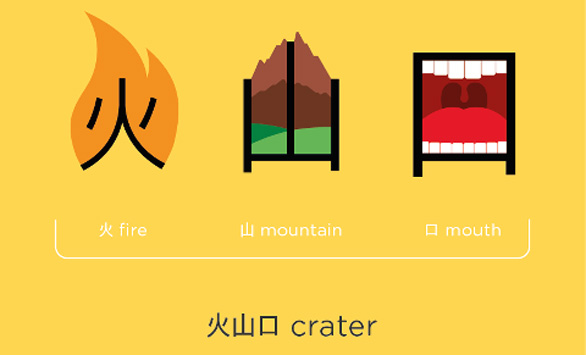 .
. - Hsueh shows us that the character for big (大) looks like a person (人) with her arms outstretched, as if to say, “Sooooo big!” Combine those two, and you get adult (大人):’
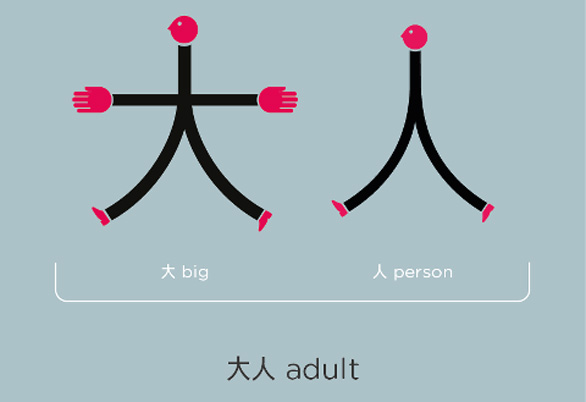 .
. - Write two suns (日) side by side and you get the character for “bright”: 昍. On her Facebook page, Hsueh writes, “I promise you, this is a character that will impress your Chinese friends. This is such a rare character that 99 percent of Chinese native speakers/readers would struggle to tell you what it is, never mind how to pronounce it.”
 .
. - Here’s a really clever one that Hsueh brings up in her talk: the character for “to dodge” or “to avoid” is composed of a person (人) inside a door (門), as if the person is sneaking out! 閃 What she adds on her Facebook page is that this character has a second meaning, “flash.” As she explains, “this person is sneaking out at such speed that the shape of him dashing resembles a streak of light.”
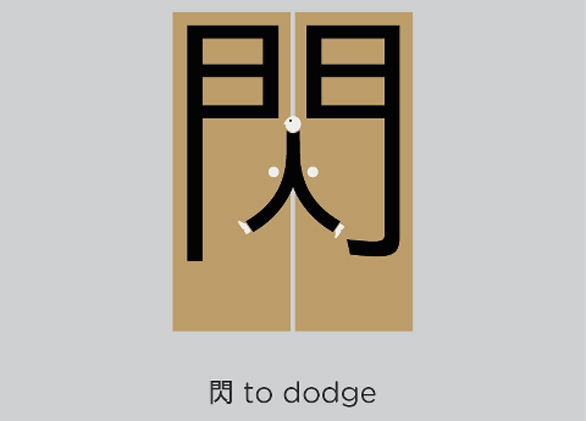
Comments (18)
Pingback: FMP Weekly Post 5: Case study- Chineasy | cm37bo
Pingback: Whizz Learning | Start reading and writing Chinese as quickly and painlessly as possible!
Pingback: [New Game] LEGO Star Wars: The Yoda Chronicles Touches Down On The Play Store, Compatible With Almost Nothing | Toki Solutions
Pingback: Sharp reportedly firing 5,000 employees, narrowing focus on smartphone displays | Toki Solutions
Pingback: Chineasy – Learn Chinese easy | Sanna K Design